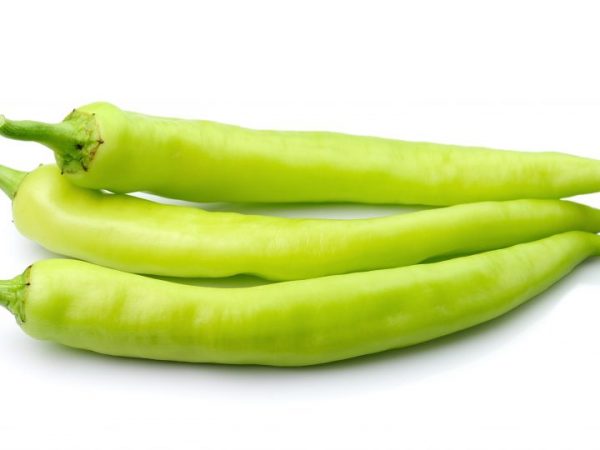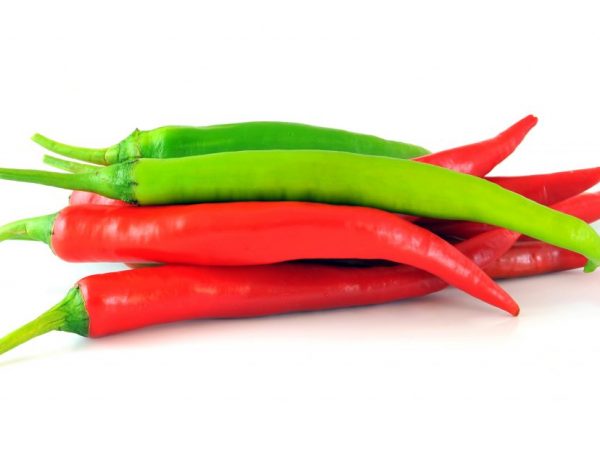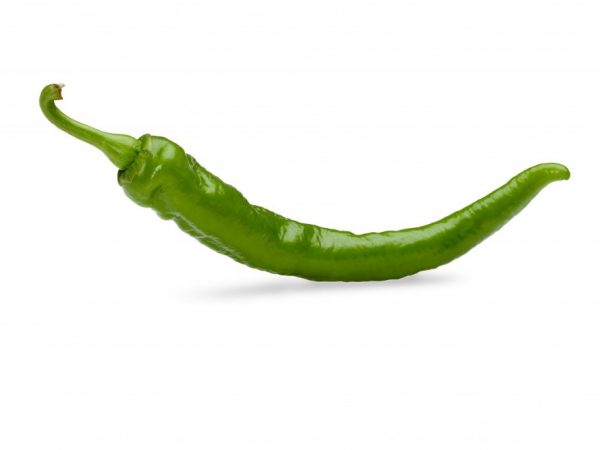Characteristics of green hot chili peppers
Green hot peppers are a well-known red chili, the fruits of which are in the technical maturity phase. By this time, the vegetable has time to get enough vitamins and microelements. It differs from red in that it is less pungent. a detailed description of the variety is presented in the article.

Green hot chili peppers
Varieties of varieties
There are several varieties of red chili that have green fruits when ripe. They have gained particular popularity. They are easy to grow in the garden, in the greenhouse and on the windowsill.
Anaheim
The variety is very popular in America. Early ripe - 90 days pass from the emergence of seedlings to picking fruits in a green form.
The bush is well leafy. No new shoots are formed. This makes it easier to care for the plant and provides the fruit with plenty of light.
The fruit is long - 15-16 cm. The width of the stalk is 4.5-5.5 cm. The shape is conical, the vegetable is flattened. The tip is pointed or concave. At biological maturity, it turns red. The pungency on the Scoville scale is 500-2500. These are averages. Has a sweet, slightly spicy aroma. Grilled, pickled, stuffed. Due to the size of the fruit, they are cut in half.
Serrano
Pepper is native to Mexico. It got its name from the Sierra Mountains. High-yielding variety. The first fruits can be harvested three months after the seed has germinated.
Spectacular perennial plant. The shrub develops rapidly.
The vegetable is bullet-shaped. The size is small - only 4 cm. The skin is smooth, glossy. The walls are rather thin. The presence of partitions inside reduces the pungency. Removing the semen also helps to reduce the pungency. In the biological phase of maturity, they acquire a red color. Has a slightly sour taste. Hot green peppers are consumed raw. Ripe - processed.
Jalapeno
Originally from Mexico. It is recommended to use fruits at the stage of technical maturity, since reds do not have such useful properties. The growing period is 70-80 days.
The bush reaches a height of 1 m. With good care, 25-35 peppers can be harvested from each.
Curved fruits. The tip is dull. The surface is smooth. Length - 5-9 cm. Weight about 50 g. They have a spicy-sharp, slightly vinegar taste. The seed contains a lot of pungency. Therefore, they are removed.
Benefit and harm
The advantage of green hot pepper is its use in different areas:
- in medical practice;
- in cosmetology;
- for dietary purposes;
- in cooking in various forms.
The medicine

Pepper is used not only for food
The burning substance found in vegetables can dull pain. Benefits for arthritis and neurosis, joint inflammation. Regular use of green chili improves immunity, improves blood circulation.
Improves metabolic processes in the body, increases appetite. Helps with various diseases: colds, bronchial asthma, insomnia, atherosclerosis, hepatitis, epilepsy and allergies.It has been shown that hot pepper fights cancer cells, therefore it is used in the prevention of cancer. It also protects tooth enamel and prevents tooth decay.
Cosmetics and diet
Due to its high content of vitamin C and capsaicin, chili peppers are often used for cosmetic purposes. It has a beneficial effect on the condition of the skin and hair. He is also able to raise body temperature. Thus, it breaks down fatty deposits. Does not work on carbohydrates. These processes will be beneficial in the fight against excess weight. Even hot peppers provide a feeling of fullness.
Cooking
Chili-based dishes acquire a spicy, pungent taste. It is consumed raw, grilled, stewed, marinated.
The benefits of hot peppers are undeniable, but they can only be used in moderation. Otherwise, it will harm the body.
The harm of this pepper is also based on medical findings. You can not use this product with existing diseases of the digestive system, especially with gastritis and ulcers: the vegetable can cause burns on the mucous membranes. It is worth excluding it from the diet for heartburn.
Care
The cultivation of hot green peppers can be done both on the windowsill and in the open field or greenhouse. For a good harvest, the plant must provide optimal conditions:
- illumination and corresponding temperature;
- watering;
- bush formation;
- loosening;
- top dressing.
Lighting
Regardless of where the plant is cultivated, it is necessary to provide it with good light. For most plants, 8 hours of daylight is sufficient, but if the sprouts are weak, it is advisable to increase this time to 12 hours. Fluorescent lamps are used for illumination.
Temperature regime

The harvest depends on care
To grow a strong adult culture, you must first take care of the health of the seedlings. The temperature in the room where it will be located should be 20˚С. After a few weeks, it is lowered gradually. Somewhere 14 days before planting, the seedlings must be hardened. Every day they are taken out into the street (for 1-2 hours in a shaded place). It is worth providing seedlings from sudden jumps in temperature and drafts.
Formation
After landing in a permanent place, pinch the top of the peppers (when they pass adaptation). This process can be carried out if the plants put in 1-2 new leaves.
Watering
Watering is carried out once a week until the culture begins to bloom. In hot weather, the amount can be increased up to two times. The dosage should be 12 liters per 1 sq. m. In the subsequent stages of cultivation, they are watered three times a week, making 14 liters of water per 1 sq. m. m.
It is imperative to form the bush correctly, then the yield will be higher. For this, pinching is carried out - only 5 upper shoots are left. The rest must be removed.
Loosening
Hot pepper will respond well to loosening the soil. It should be done regularly, but carefully so as not to cause harm. After all, the root system of a plant is superficial and can be damaged.
Top dressing
Some gardeners advise not to use fertilizer at all. This is provided that the soil is enriched with nutrients. To do this, use ash, chicken droppings or rotted mullein in the fall and dig it up. But during the growth of a hot pepper, you can feed it with a complex fertilizer. It is brought in every two weeks, dosing strictly according to the instructions.
Diseases and pests
Chili peppers can affect the following diseases:
- bacterial spotting;
- anthracnose;
- gray mold;
- white rot;
- tobacco mosaic virus.
In order to prevent them, it is necessary to correctly carry out the agrotechnical process. It is also worth collecting all plant residues from the site, disinfecting the soil and seed.
For medicinal purposes, plants are treated with 1% Bordeaux liquid. It helps fight fungi. You can spray the culture every 3 weeks with insecticides.The drugs are used according to the indicated instructions.
Conclusion
Green hot peppers have many beneficial properties and qualities. Its benefits have been proven by both physicians and traditional healers. Became popular for its universal use.
You can grow a plant both at home and on the site. And unpretentious care will satisfy every gardener.


